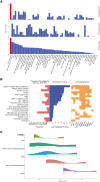Genomic Correlations, Shared Loci, and Drug Targets Between Polycystic Ovary Syndrome and Asthma: Insights From Genome-wide Association Analysis
- PMID: 40339110
- PMCID: PMC12342372
- DOI: 10.1210/clinem/dgaf276
Genomic Correlations, Shared Loci, and Drug Targets Between Polycystic Ovary Syndrome and Asthma: Insights From Genome-wide Association Analysis
Abstract
Background: Observational studies have shown an association between polycystic ovary syndrome (PCOS) and asthma-related traits. However, whether this association is genetically driven or arises from observational biases remains unclear.
Methods: This study integrated data from 10 074 PCOS cases and asthma-related traits obtained from the UK Biobank and FinnGen cohorts. Global and local genetic architectures were examined using pleiotropic analysis under the composite null hypothesis, functional mapping and annotation of genetic associations, and fine-mapping credible set analysis. Drug database mining was employed to identify pleiotropic genes as potential therapeutic targets. Tissue and cell enrichment analyses were conducted to uncover shared biological mechanisms.
Results: We identified 3 novel significant genetic loci for asthma subtypes (2 for allergic asthma and 1 for childhood asthma). A positive overall genetic correlation between PCOS and asthma-related traits was observed. We discovered 5 pleiotropic causal regions encompassing 13 genes, with ERBB3 emerging as a potential central gene contributing to the shared pathophysiology of PCOS and asthma-related traits. Additionally, drug repositioning analysis suggested anakinra and artenimol as potential therapeutic candidates for PCOS and asthma comorbidity. The linkage disequilibrium score for the specific expression of genes analysis, along with transcriptome-wide association studies, further identified gene expression patterns at the tissue/cell level in the hypothalamo-pituitary, exocrine/endocrine, respiratory, and urogenital systems.
Conclusion: Our findings provide novel insights into the genetic basis and biological processes underlying the association between PCOS and asthma-related traits, warranting evaluation of whether PCOS-specific asthma risk assessment could improve clinical outcomes.
Keywords: asthma; genetic architecture; genome-wide association studies; polycystic ovary syndrome.
© The Author(s) 2025. Published by Oxford University Press on behalf of the Endocrine Society.
Figures


Similar articles
-
Associations between kisspeptin hormone level and its genetic polymorphisms with polycystic ovary syndrome.Int J Gynaecol Obstet. 2025 Jul 24. doi: 10.1002/ijgo.70411. Online ahead of print. Int J Gynaecol Obstet. 2025. PMID: 40704698
-
Bidirectional Mendelian randomization to explore the causal relationships between body mass index and polycystic ovary syndrome.Hum Reprod. 2019 Jan 1;34(1):127-136. doi: 10.1093/humrep/dey343. Hum Reprod. 2019. PMID: 30496407 Free PMC article.
-
Integration of functional genomics and statistical fine-mapping systematically characterizes adult-onset and childhood-onset asthma genetic associations.Genome Med. 2025 Apr 10;17(1):35. doi: 10.1186/s13073-025-01459-z. Genome Med. 2025. PMID: 40205616 Free PMC article.
-
Ovarian surgery for symptom relief in women with polycystic ovary syndrome.Cochrane Database Syst Rev. 2017 Nov 10;11(11):CD009526. doi: 10.1002/14651858.CD009526.pub2. Cochrane Database Syst Rev. 2017. PMID: 29125183 Free PMC article.
-
In vitro maturation in subfertile women with polycystic ovarian syndrome undergoing assisted reproduction.Cochrane Database Syst Rev. 2025 Feb 6;2(2):CD006606. doi: 10.1002/14651858.CD006606.pub5. Cochrane Database Syst Rev. 2025. PMID: 39912435
References
-
- Legro RS, Urbanek M, Kunselman AR, Leiby BE, Dunaif A. Self-selected women with polycystic ovary syndrome are reproductively and metabolically abnormal and undertreated. Fertil Steril. 2002;78(1):51‐57. - PubMed
-
- Hoeger KM, Dokras A, Piltonen T. Update on PCOS: consequences, challenges, and guiding treatment. J Clin Endocrinol Metab. 2021;106(3):e1071‐e1083. - PubMed
-
- Htet TD, Teede HJ, de Courten B, et al. Asthma in reproductive-aged women with polycystic ovary syndrome and association with obesity. Eur Respir J. 2017;49(5):1601334. - PubMed
MeSH terms
Grants and funding
LinkOut - more resources
Full Text Sources
Medical
Research Materials

